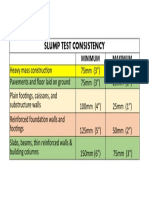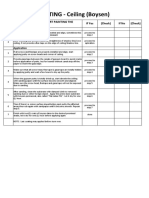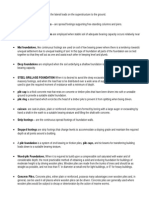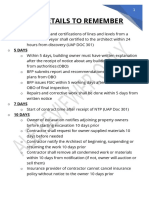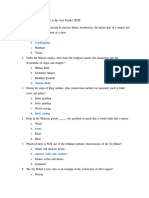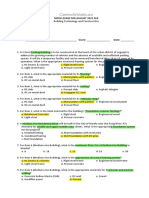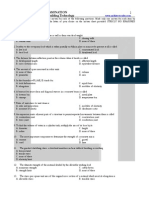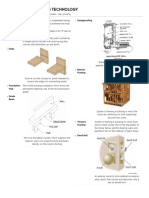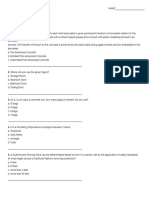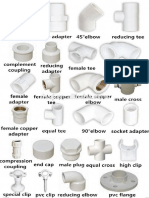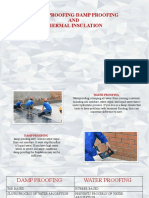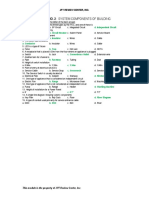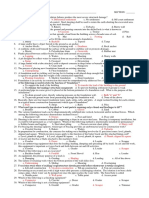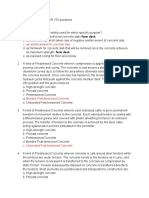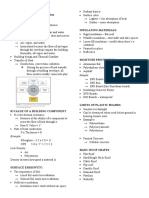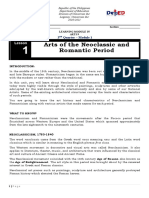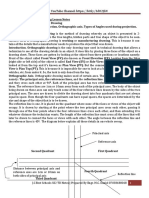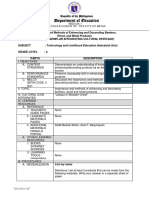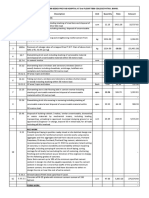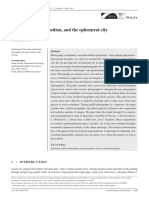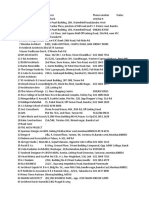0% found this document useful (0 votes)
362 views3 pagesPaint Problems Building Tech Notes
This document summarizes various paint problems including their causes and descriptions. It discusses issues such as adhesion, alligatoring, blistering, brush marks, bubbling, cracking, darkening, dirty surfaces, efflorescence, flaking, poor hiding, lapping, mudcracking, obvious repairs, peeling, poor print resistance, roller marks, rust, and sagging. The document provides the definitions and root causes for each problem to help identify and address potential painting issues.
Uploaded by
corazon philCopyright
© © All Rights Reserved
We take content rights seriously. If you suspect this is your content, claim it here.
Available Formats
Download as DOCX, PDF, TXT or read online on Scribd
0% found this document useful (0 votes)
362 views3 pagesPaint Problems Building Tech Notes
This document summarizes various paint problems including their causes and descriptions. It discusses issues such as adhesion, alligatoring, blistering, brush marks, bubbling, cracking, darkening, dirty surfaces, efflorescence, flaking, poor hiding, lapping, mudcracking, obvious repairs, peeling, poor print resistance, roller marks, rust, and sagging. The document provides the definitions and root causes for each problem to help identify and address potential painting issues.
Uploaded by
corazon philCopyright
© © All Rights Reserved
We take content rights seriously. If you suspect this is your content, claim it here.
Available Formats
Download as DOCX, PDF, TXT or read online on Scribd
/ 3
Module 10: Paints depressions (cratering) when bubbles
Paints – high amount of pigment break
Stains – little to no amount or pigment, Cause: shakingly partially filled can of
contains mostly solvent paint, excessive brushing, use of roller,
Varnishes – clear coating, solvent or water- applying gloss or semi-gloss paint over a
based porous or unsealed surface,
Lacquers – clear coating, solvent-based, thinner/reducer that is inappropriate
nitrocellulose Burnishing (Shiny Area)
Sealers – seals the substrate Area that shows an
unwanted increase
Paint Problems: in gloss or sheen,
Adhesion (Blocking) rubbing
Paint sticks to itself or to the weather Cause: use of flat
stripping when a window or door is paint in high-traffic
opened areas, frequent
Cause: Not sufficient drying time between washing and spot cleaning, heavy objects
paints, low block resistance paint rubbing against wall, low resistance paint
Alligatoring Caulk Failure
Patterned cracking in Loss of caulk’s
the paint film initial adhesion and
flexibility, causing
Cause: natural aging
painted caulk to
of oil-based paints,
crack and pull away
rigid coating like oil
from the surfaces to
enamel, topcoat
which it is applied
before primer, coating over glossy finish
Cause: lower-quality caulk, wrong type
Blistering
of caulk, not priming the surface, too thin
Bubbles caused from
application, or caulk
loss of adhesion and
Chalking (Powdering)
lifting of the paint
Formation of
Cause: Heat
fine white
blistering, moisture
powder on the
blistering, oil-based
surface due to
or alkyd paint over a damp or wet surface,
weathering,
exposure of latex paint film to dew, damp
color fading, excessive paint film erosion
basements, moisture in the interior walls,
insufficient surface preparation Cause: oil-based paints tend to chalk more
than latex formulations, use of low-grade
Brush or Roller Marks
highly pigmented paint, over thinning
Failure of paint to
Cracking
dry to a smooth film,
unsightly brush Splitting of a dry paint film, through at
marks least one coat. May appear first as hairline
cracks, flaking occurs later
Cause: additional
paint or re-brushing, Cause: use of a paint that has lower
working paint too adhesion and flexibility properties, over-
much, wrong nap size of roller, thin paint, thinning, over-spreading the paint,
hot surface painting, porous surface embrittlement paint, inadequate surface
preparation
Bubbling
Darkening
Formation of air
bubbles (foaming) Wood with appearance of severe mildew
and resulting small, but will not lighten when tested with
round concave bleach.
Cause: caused by ultraviolet radiation, Cause: Touch-up with a different tool,
occur on wood with no protective coating, different batch of paint, repair has a
occur under varnishes different texture, touch-up at a different
Dirty/Soiled temperature
Accumulation of dirt, dust particles, other Peeling
debris on the paint film Loss of adhesion of a coating to the
Cause: soil splashing onto sliding, air substrate or an earlier coating
pollution, and car exhaust Cause: seepage of moisture, leaks in
Efflorescence roof/walls, painting over a dirty surface,
Crusty, white salt painting over a coating that already has a
deposits, leached marginal adhesion
to the surface of Peeling (Metal)
mortar or Has lost its adhesion to a galvanized metal
masonry substrate
Cause: interior Cause: alkyd/oil paint, zinc of galvanized
moisture, exterior metal, unpainted galvanized metal, cold or
moisture, basement walls that are not humid conditions
sealed, insufficient curing Peeling (Plaster)
Flaking Loss of a coating’s adhesion from plaster,
Lifting of paint from the underlying which can occur in spots or larger areas
surface in the form of flakes, preceded by Cause: peeling from plaster, hard plaster,
cracking or checking high PH, old plaster that is powdery, poor
Cause: cracking of exterior wood, poor surface preparation
paint penetration, hard grain pattern, poor Poor Print Resistance
surface preparation Paint film to take on the imprint of an
Poor Hiding (Transparent) object that is placed on it
Failure of dried paint to obscure or hide Cause: not waiting until the coating has
the underlying color dried, poor print resistance, cool or humid
Cause: too thin of a paint film, paint with considerations, low quality latex semi-
low hiding characteristics, paint that is gloss
much lighter, painting over a porous Roller Marks/Stippling
surface, thinning/reducing the coating Unintentional textured pattern left in the
Lapping paint by the roller
Appearance of a darker/denser color or Cause: incorrect roller cover, incorrect
higher sheen rolling technique
Cause: Failure Roller Splattering
to maintain a Tendency of a roller to throw off small
wet edge, paint droplets of paint during application
on unsealed Cause: applying the coating too fast, using
surface, paint a roller cover with wrong nap,
under high overloading the roller cover, overworking
temperatures the paint once it is applied to a substrate,
Mudcracking thinning of a product
Deep, irregular, cracks resembling dried Rust
mud in the dry paint film Reddish-brown stains on the paint surface
Cause: applied too thick, build-up in Cause: steel in contact with air and
corners, surface was not prepared moisture will rust, steel nails may develop
Obvious Repair (Touch-Up) black discoloration when in contact with
A repaired or repainted area that is damp wood that possesses high amount of
noticeably different than the surrounding tannic acid
space Sagging
Dropping of the paint to rain, insufficient curing,
paint film contaminated surface
immediately after
application
Cause: too heavy a
coat of paint,
application in
excessively humid
conditions, over-thinned paint, painting
over a glossy surface, over a surface
contaminant
Staining (Tanning)
Brownish or tan discoloration on the paint
surface due to migration of tannins from
the substrate
Cause: occurs in staining woods,
redwood, cedar, mahogany
Uneven Color
Non-uniform appearance of color that
occurs when a wall is painted with a roller
and the edges are cut in with a brush
Cause: paint at different film builds, not
keeping a wet edge while painting,
incomplete mixing of the paint
Uneven Gloss (Flashing)
Deterioration of the paint film, resulting
in excessive or rapid loss or gloss/luster
of the topcoat
Cause: use of gloss alkyd/oil-based paint
or solvent-based epoxy, heavy dew,
moisture, temperature fluctuations,
coating over a porous surface, paint
applied at uneven film
Wax Bleed (Hardboard Siding)
Splotchy dirt
collection,
resemble mildew
growth
Cause: stains from
waxy substance,
staining
substances bleed through the primer, oily
or waxy feeling
Wrinkling
Rough, crinkled
paint surface,
forms a skin
Cause: paint
applied too
heavily, paint
under extreme hot conditions, uncured








